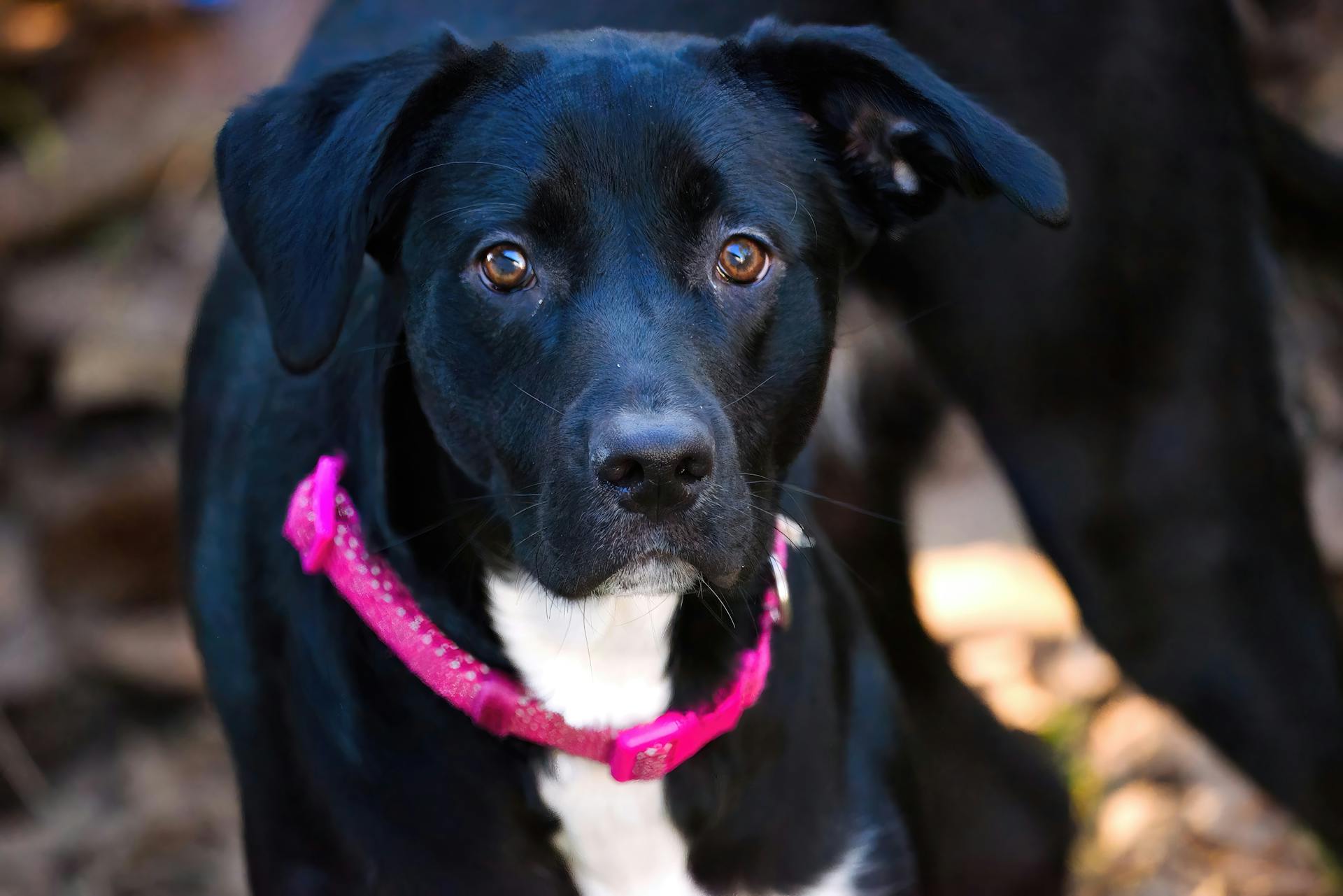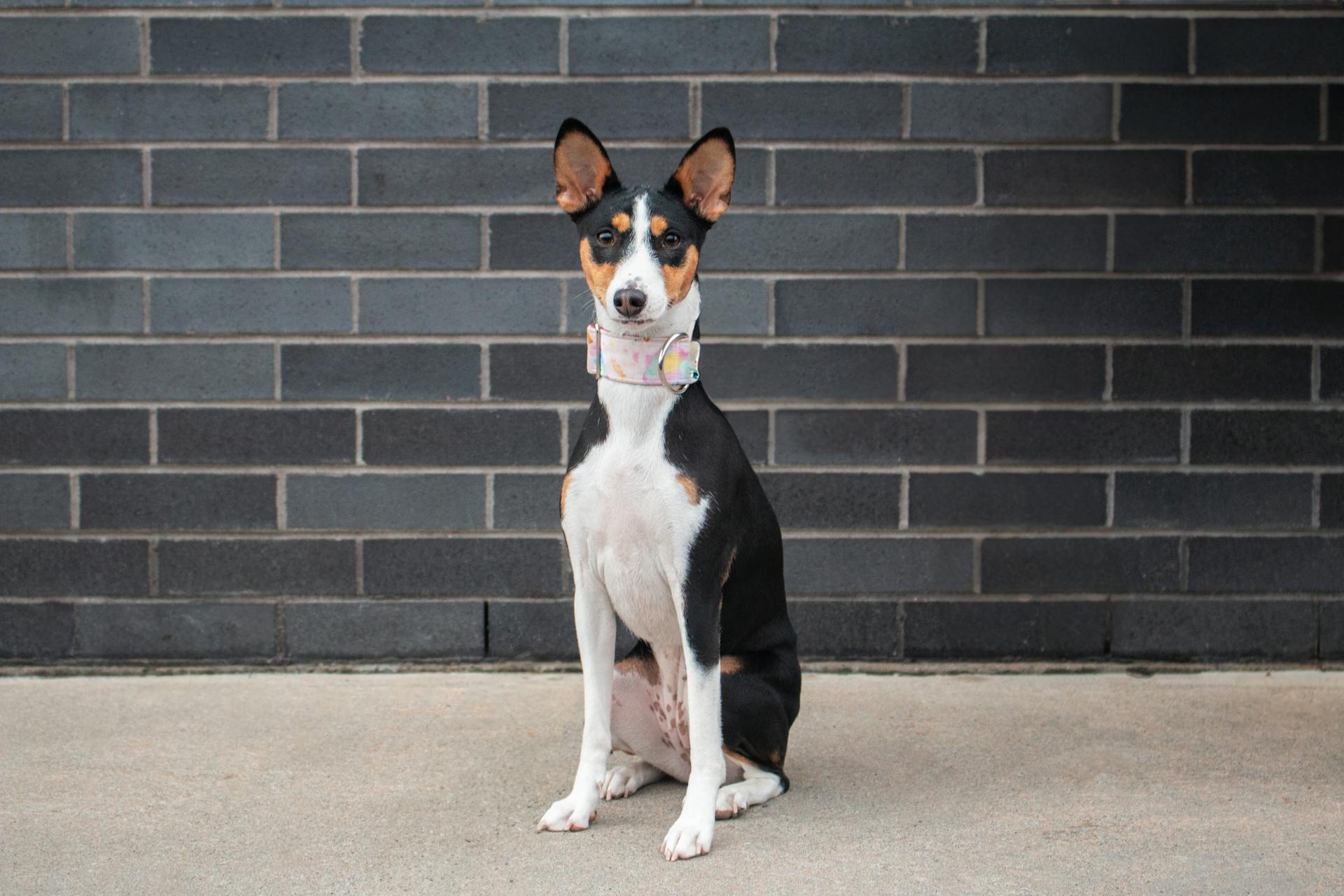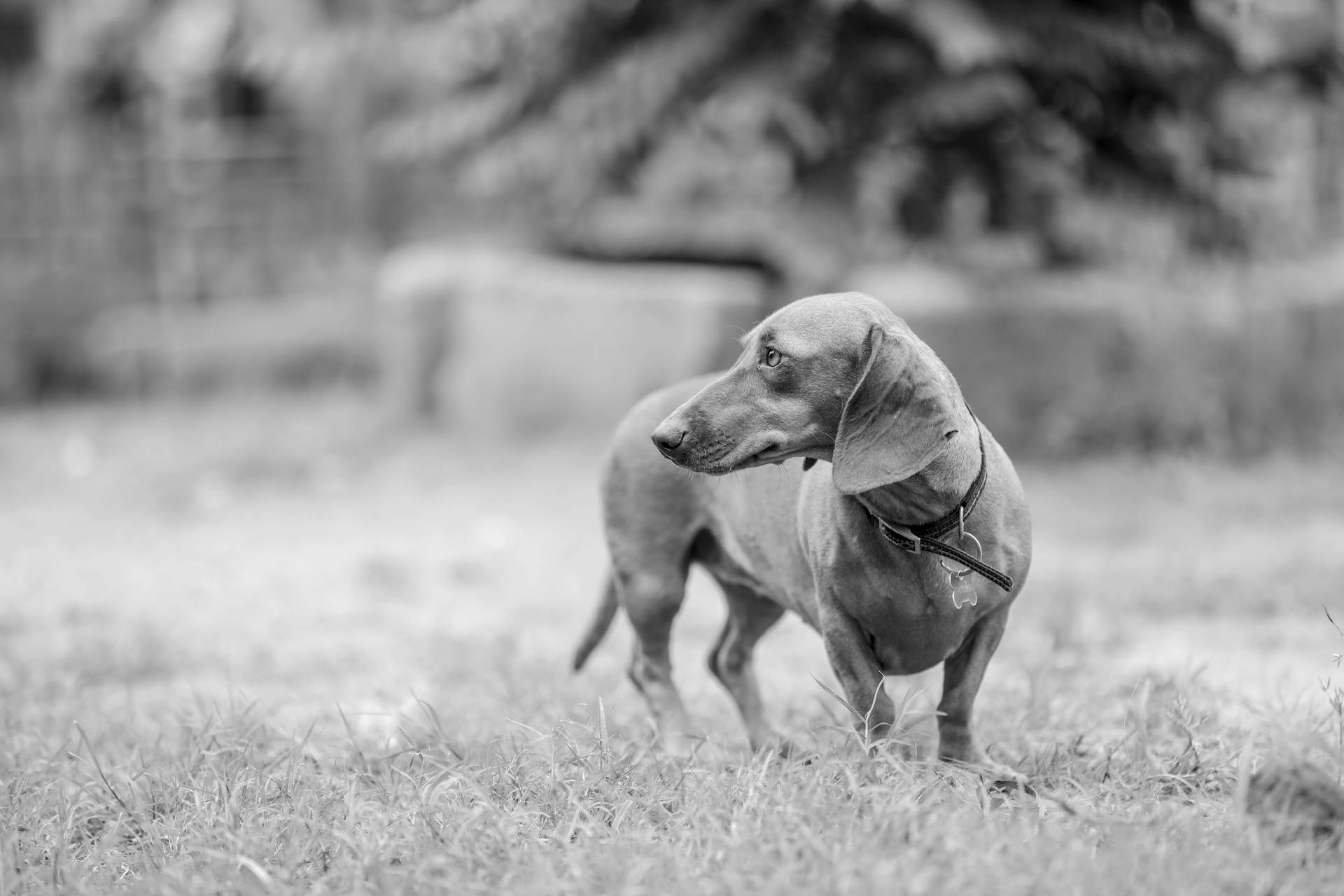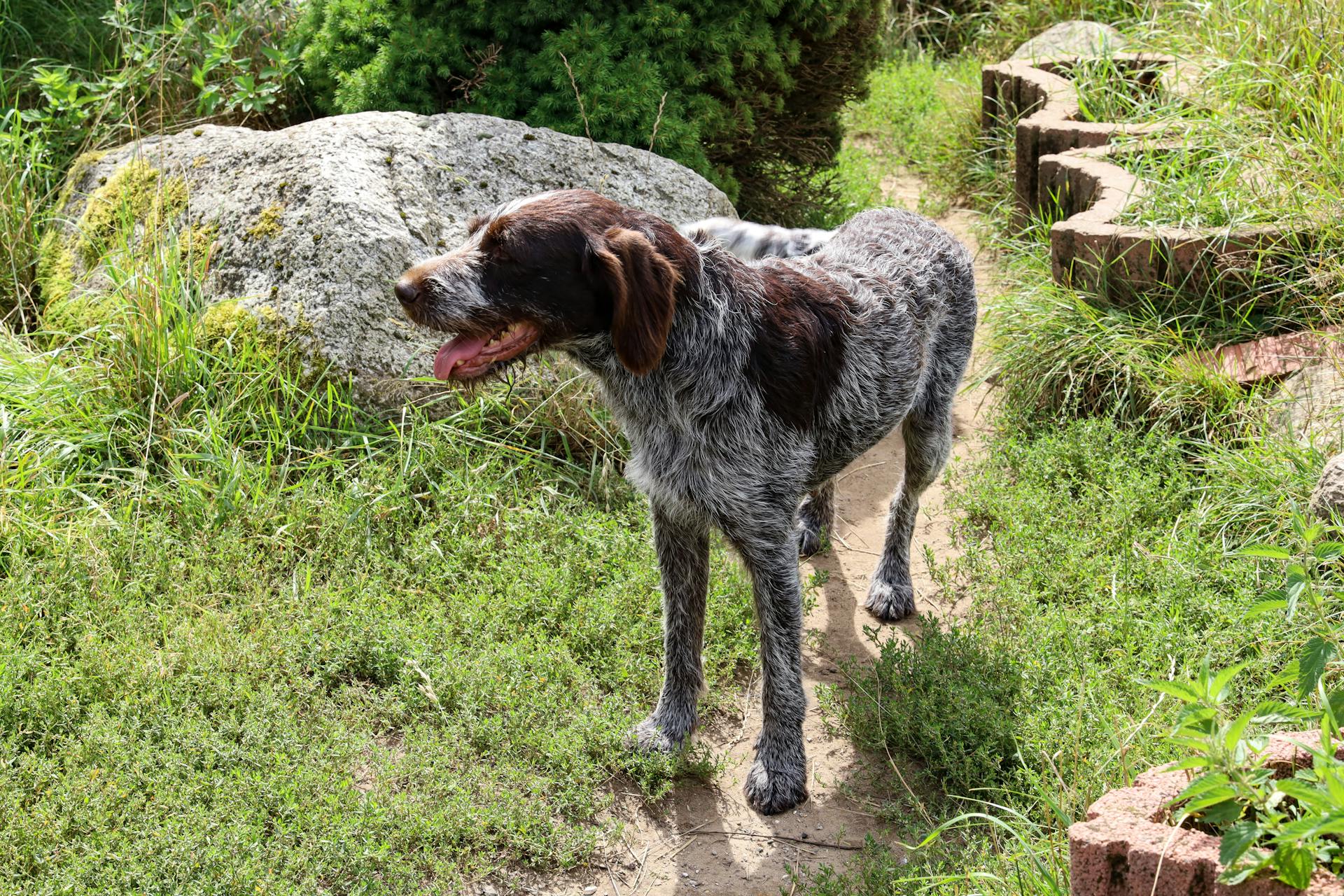
The Patterdale Terrier is a breed that's built for hunting, with a strong prey drive and a keen sense of smell. They were originally bred to hunt small game like foxes and badgers in the Lake District of England.
Their compact size and agility make them well-suited for navigating tight spaces and chasing game in dense terrain. In fact, they're often used to hunt in packs, working together with other terriers to flush out their quarry.
Patterdale Terriers are also known for their intelligence and strong will, which can make them a challenge to train for inexperienced owners. However, with the right approach and positive reinforcement, they can learn to obey commands and respond to their handler's signals.
A different take: Hunt Terrier
History
The Patterdale Terrier's history is deeply rooted in its origins as a working dog in the Lake District region of England. They were first bred in the 1960s as a working dog to protect newborn lambs from foxes.
These tough little dogs were capable of hunting foxes and digging them out of their dens to dispatch them. They were skilled hunters of all types of vermin.
The Patterdale Terrier's ancestors were the Fell Terrier, a group of long-legged working terrier breeds from Great Britain. This group also includes the Lakeland Terrier and the Scorrier Terrier.
They were bred to bolt the quarry out of the den or to dispatch it if it chose to fight. Their characteristics result in an extremely game, 'tough as nails' dog.
Farmers valued them not just for their hunting skills but also as loyal companions. Today, Patterdale Terriers are known worldwide, celebrated for both their working abilities and suitability as pets.
Here is a list of the Patterdale Terrier's original uses:
- Protecting newborn lambs from foxes
- Hunting foxes and digging them out of their dens
- Hunting all types of vermin
The Patterdale Terrier's adaptability and intelligence made them highly sought after as working dogs. They were used for groundhog, raccoon, fox, and nutria hunting in the United States with great success.
In the UK, the use of "hard" dogs to hunt foxes was made illegal in 2004, but the Patterdale Terrier's legacy lives on as a beloved working dog and loyal companion.
Physical Characteristics
The Patterdale Terrier is a sturdy and active little dog, built for working underground to follow its quarry. They stand between 10 and 15 inches tall at the withers, with a strong neck, powerful jaws and teeth, and great flexibility and endurance.
Their coat is dense and wiry, coming in a variety of colours including black, red, chocolate, and bronze. The coat can be one of three types: smooth, broken, or rough, with all types having a dense and coarse double coat that's harsh to the touch and weatherproof.
Their average height is 25-40 cm, and weight ranges from 5-7 kg. They have a broad head with a short muzzle and dark, expressive eyes, and are known for their determination and alertness.
Here are the acceptable coat types and colours:
- Smooth coat: Short, glossy hair. Undercoat still usually present.
- Broken coat: Coarse. May be some longer whiskering on muzzle and chin.
- Rough coat: Longer hair overall, including face, ears, and muzzle. Very thick, protective double coat.
- Acceptable colours: black, red, liver/chocolate, grizzle, black and tan, and bronze.
General Appearance
The Patterdale Terrier is a sturdy, tough, and active little dog that presents a compact, balanced image. They have a broad head with a short muzzle and dark, expressive eyes.
Their height ranges from 10 to 15 inches at the withers, making them a small but powerful breed. This breed is worked far more than it is shown, so it's no surprise that they have a strong neck, powerful jaws, and teeth, and great flexibility and endurance.
Their coat is typically dense and wiry, coming in black, red, chocolate, or bronze. A Patterdale Terrier should be able to squeeze into tight burrows, and they're known for their determination and alertness.
They have an energetic gait that complements their lively disposition, and their weight should be in proportion to their height, with no excess fat. Scars resulting from wounds received while working are considered honorable and are not to be penalized.
Coat and Colour
Patterdale Terriers have three main coat types: smooth, broken, and rough. Each type is distinct in its texture and length.
A smooth coat is coarse, dense, and stiff, with no wave. Broken coats, on the other hand, have coarse, wiry guard hairs that are longer than those of the smooth coat type. Dogs with broken coats may also have facial furnishings that form a beard, mustache, and eyebrows.
Check this out: Fox Terrier Smooth
Rough coats are coarse and longer than the other coat types, and they always have furnishings. This is a key characteristic of the Patterdale Terrier breed.
Patterdales can be solid in color, with no white markings, or have some white markings on the chest and feet. Acceptable colors include black, red, liver/chocolate, grizzle, black and tan, and bronze.
Here's a breakdown of the standard coat colors for Patterdales:
- Black
- Red
- Liver/Chocolate
- Grizzle
- Black and Tan
- Bronze
It's worth noting that some colors may have variations, such as lighter hairs in the black coat or more or less black and tan coloring.
Temperament and Care
Patterdale Terriers are known for being bold and confident beyond their capabilities, making them perfect for a life of hunting.
They require consistent training to thrive, especially in active households where they can get the exercise they need to stay mentally and physically stimulated. Regular walks, playtime, and interactive toys are essential for their well-being.
Patterdales are feisty, loyal dogs that make excellent companions for experienced pet parents, but they can be prone to separation anxiety if left alone for long periods. This can lead to destructive behavior, so it's essential to provide them with plenty of attention and social interaction.
A weekly brush and occasional bath are usually sufficient to keep their coat in good condition, requiring minimal grooming. However, their strong prey drive means they may not be a good fit for homes with other small pets.
Patterdales are good enough with strangers but not so good with unfamiliar animals, so socialization is crucial when they're puppies to prevent them from being fearful or reactive. A secure, fenced yard is also a must to keep them safe and prevent them from chasing neighborhood critters.
Grooming and Health
As a Patterdale Terrier owner, you know how important regular grooming is for your dog's overall health and well-being. Brush your Patterdale's coat weekly with a slicker brush to remove loose hair and prevent tangles.
Regular nail trims are a must to prevent overgrowth, which can be painful for your dog. Trimming your Patterdale's nails every few weeks will keep them in check.
Ear cleanings are also essential to prevent infections and keep your dog's ears healthy. Clean your Patterdale's ears regularly to keep them free of dirt and wax.
Dental hygiene is crucial for Patterdale Terriers, as dental disease is one of the most common health conditions in adult dogs. Regular teeth brushing and professional cleanings will help reduce dental risks for your pup.
Exercise and Training
Patterdale Terriers need regular exercise and mental stimulation to stay happy and healthy. Consistent training using positive reinforcement helps manage their energetic nature effectively.
A minimum of 30-60 minutes of exercise each day is essential for Patterdale Terriers, along with plenty of mental stimulation. Activities like brisk walks and interactive games help meet their energy needs.
Regular exercise prevents boredom-related behavior issues in Patterdale Terriers. Engaging in activities that provide both physical and mental stimulation is key to a happy and well-behaved Patterdale Terrier.
Patterdales are intelligent and stubborn, so a firm but gentle approach is necessary for training. Positive reinforcement and fun training sessions help keep them engaged.
Curious to learn more? Check out: Bernese Mountain Dog Exercise
For safe and comfortable walks, a harness like the Ruffwear Front Range Harness is a great option. It provides control and comfort, allowing your energetic Patterdale to explore without compromising safety.
Training sessions should be kept short and fun to avoid overwhelming your Patterdale. With patience and consistency, you can develop a strong bond with your dog.
Featured Images: pexels.com


